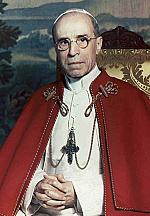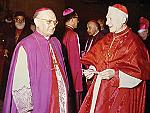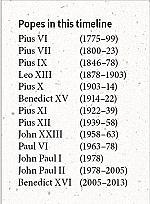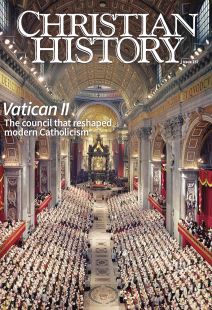Witch hunts and “new theology”
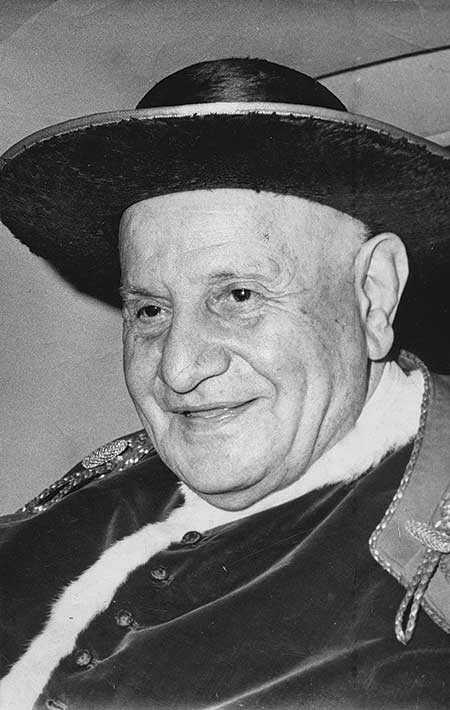
[Pope John XXIII. Circa 1962—Brazilian National Archives / Public domain]
In the half century before Vatican II, the world struggled through staggering changes. Humanity suffered “the war to end all wars,” soon followed by a second, even more terrifying world war; the Russian Revolution led to the rise of communism; the Spanish flu and the Great Depression destroyed millions of lives; Nazis and fascists goose-stepped through the streets of Europe; the Holocaust and the atomic bomb shocked the conscience of the world; a wave of decolonization throughout Asia and Africa brought hope amid instability; a Jewish state of Israel was established for the first time in millennia; the dawn of the sexual revolution and the civil rights era changed Western culture forever; and a Cold War began that had no end in sight, behind which the possibility of nuclear annihilation lurked. All this in the span of about 50 years!
Understanding Vatican II and its agenda requires taking into account the varied and conflicting Catholic responses to an array of tumultuous world events as well as internal church challenges. Two key internal challenges ultimately came to a head at the council. The first was the need to balance diversity within unity. This was a particularly pressing challenge for an ever-expanding and diversifying world community led from Rome, where enormous practical and theoretical power was invested in a single person—the pope. The second challenge, one that Protestants experienced in equal measure, was how Catholics could preserve and defend a supernatural faith “once for all delivered to the saints” (Jude 1:3) with the intellectual depth and rigor required in a rapidly changing, modern world.
Centralized Rome: blessing or curse?
Pope Pius IX went to his grave proud of the spiritual authority that had been consolidated in his pontificate. After centuries of dispute, Vatican I had successfully asserted the pope’s supreme teaching and jurisdictional authority in the universal church, even when it was exercised outside of an ecumenical council. (An irony, since it took a council to definitively establish this doctrine, see pp. 12–16.)
The dominant “ultramontane” (pope-centered) stream of nineteenth-century and early twentieth-century Catholicism was proudly unecumenical, imbued with Romanticism, and emboldened by conservative resurgences in politics and religion. Ultramontane culture was marked by a triple devotion: to Mary and her multiplying apparitions, to the inviting image of Jesus with his Sacred Heart open to sinners, and finally to the person, office, and teaching of the pope, who functioned as a patriarchal bulwark against the “errors” and excesses of the modern world, from unbridled capitalism and birth control to atheism and communism.
When it came to the question of papal infallibility, a “minimalist” perspective, associated with John Henry Newman, was always tolerated. Indeed, after Vatican II, this minimalist perspective, which accepted papal infallibility but sought to limit its scope, became the norm. But the pope’s essentially untrammeled authority, which was built up with increasing effectiveness during this period, remains the status quo in the church to this day. Probably the most important development in this regard is the pope’s relatively recent right to appoint (and depose) virtually all the world’s bishops—a power unthinkable before the French Revolution toppled the old political regime in 1789 (see p. 11). Coupled with Roman control of the process of the codification of church law in the 1917 Code of Canon Law (and again in 1983), the papacy has more direct control over the Catholic Church now than at any time in the first 1,800 years of Christianity.
Despite concentrated power’s threat of corruption, papal centralization did have its benefits; namely, in making necessary moral and strategic decisions for the global Catholic Church. For example, Pius XI’s decision to ordain native-born bishops (like the six Chinese men he consecrated in 1926) meant that the days of feet-dragging on the issue of indigenous clergy were definitively numbered. John XXIII’s calls in the early 1960s “for the elimination of every trace of racial discrimination” put Catholics ignoring or resisting the civil rights movement in an ultimately untenable position. It is difficult to imagine how the contemporary Catholic Church could, practically speaking, truly remain one ecclesial body from Santiago to Brussels and from Seoul to Cape Town without the papal rock at the center of it all.
However, Vatican II’s response to this period of papal consolidation of power was mixed, even paradoxical. On one hand, the bishops quite boldly asserted that they were themselves successors of the apostles and that St. Peter wasn’t a king but rather a servant-leader who had guided the Christian community in collaboration with the Twelve and other apostolic leaders. But the reformist majority at Vatican II was unable or unwilling to revise papal and curial day-to-day control of the church. Popular perceptions equating the opinions of the pope with the teaching of the Catholic Church and views of the pope as a kind of spiritual celebrity or even an oracle have arguably increased rather than decreased since Vatican II.
Modernism: heresy or honesty?
The crisis of “modernism” that gripped the church around the turn of the twentieth century was a Catholic version of similar debates raging in the Protestant world over “liberal” and “fundamentalist” views of the Bible. Debates over Scripture took center stage for Catholics, with more liberal Catholics arguing that the early chapters of Genesis were spiritual and allegorical truth, but not history; that the Pentateuch was not the work of Moses but of a long redaction process; and that the book of Isaiah was actually the work of multiple authors.
While their opponents in the church did not necessarily assert a thorough-going fundamentalism in response to historical criticism, they did fear that these new “modernist” interpretations of the Bible would undermine divine revelation and trust in the tradition and teaching authority of the Catholic Church. Thus a Catholic “fundamental” response to modernism came from the top down.
This defensive posture reached its apex, or nadir, under Pius X (r. 1903–14). Pius should be commended for being close to the common people and a warm and conscientious pastor. He is fondly remembered for emphasizing daily reception of Holy Communion and lowering the age of First Communion. Unfortunately, however, he had none of the prudence or subtlety of his predecessor Leo XIII (r. 1878–1903), who was a fine exemplar of conservative innovation and adaption in response to the intellectual, political, and social challenges of his time. Pius X, on the other hand, happily assumed the mantle of a reactionary, reveling in his own seemingly absolute spiritual authority. His bull-in-a-china-shop mentality in the face of perceived enemies outside of church and traitors within had disastrous consequences.
It was not as if Catholicism, indeed Christianity as a whole, was not facing serious intellectual challenges. New waves of thought in the realms of theology, philosophy, politics, and ethics—the question of “modernity” as a whole—posed grave challenges to the Christian faith as it was traditionally conceived. As with all challenges, however, modernity also posed opportunities. Some intellectually adventurous Catholics engaged optimistically and openly with modern philosophy, attempting to speak to the “turn to the subject” that they believed required at least a new apologetic, if not a radical rethinking of the Catholic faith. Others engaged with critical research on the Bible, reexamining the development of doctrine through the lens of the New Testament and the faith of the earliest Christians. And others, for religious as well as political and social reasons, challenged established notions of authority, obedience, and hierarchy in the civil and ecclesiastical realms.
Pope Pius X seems to have sincerely believed that these loose networks of intellectuals were in fact a coordinated group of subversives, and that without an equally coordinated reprisal and suppression, this new heresy of “modernism” would destroy the church from within. Thus he felt unseemly methods were entirely justifiable. A secret society known as the Sodalitium Pianum (The Society of Pius V), led by the fanatic and anti-Semite Umberto Benigni (1862–1934), provided an extreme template for antimodernist witch-hunting around the world by spying, denouncing, and intimidating suspected modernists, sometimes for the offense of reading the wrong books.
Pius X brought the heavy ecclesiastical artillery with an encyclical called Pascendi Domini Gregis (1907), which included instructions for “Councils of Vigilance” in each diocese (local church territories) tasked with rooting out the many-headed hydra of modernism. In Pascendi, Pius X defined modernism as an all-encompassing “synthesis of all heresies”—an ideological cancer that was at root philosophical but had theological and even political and social dimensions. Predictably fear, suspicion, gossip, and score-settling abounded. In 1910 Pius X ordered that all candidates for ordination take an “anti-Modernist Oath”—a mandate that was only rescinded in 1967, after Vatican II wrestled with and rejected the once-hegemonic antimodernist ideology.
Suspicious questions
As a coordinated movement, modernism never existed. Pius X had created a monster from his own nightmares. And yet, real people asking real questions certainly did exist. Most were Catholic intellectuals wrestling with the latest learning in science, philosophy, and history in a faithful way. Some, however, did go too far. One of the most famous “modernists,” the French biblical scholar Alfred Loisy (1857–1940), ultimately apostatized. Initially Loisy’s historical-critical work sparked lively debate because he said that Jesus had in fact preached the Kingdom of God, but what followed after him was the church. Unfortunately the increasingly radical conclusions of Loisy’s research, and his frustration with clerical conservatism, led him out of the Christian faith entirely. But Loisy was one of a handful of exceptions. Pius X’s antimodernist crusade was, for the most part, a tragic exercise in kicking the can down the road, leaving a trail of ruined careers.
Despite the damage done by antimodernist witch-hunts, intellectually adventurous Catholics continued to think creatively about how to engage fruitfully with contemporary scholarship, rather than ignore or caricature it. Theologically the most significant movement to arise was known, originally pejoratively, as the nouvelle théologie or “new theology.” Many of them were French priests and typically of the Jesuit or Dominican orders, though scholars in Germany, Belgium, and the Netherlands also contributed to this new movement. These Catholics adopted a way of doing theology that was distinct from the “neoscholastic” method enforced since 1879, when Leo XIII promoted a revamped “Thomism” (based on the medieval giant Thomas Aquinas) in the face of modern philosophical “errors” that had sprouted up since the Enlightenment.
Instead “new theologians” like the Jesuit Henri de Lubac (1896–1991) and the Dominican Yves Congar (1904–1995) sought to go back to the wellsprings of Christian life, found especially in the Bible and the church fathers. The guardians of neoscholastic orthodoxy, however, like Réginald Garrigou-Lagrange (1877–1964; himself a French Dominican), saw in these thinkers a new, more covert form of modernism. The “new” theologians’ interest in philosophical subjectivity and critical study of the Bible and church history was seen as theologically dangerous, and their general cultural and political proclivities were suspiciously progressive.
But unlike many of their unlucky forebears, proponents of the nouvelle théologie were about to be vindicated. Pius XII’s elderly, jolly, and fat successor John XXIII (Angelo Roncalli, r. 1958–1963)—seen by most people as a “stop-gap” pope—made the shocking decision to convene an ecumenical council. Even more shocking, it soon became clear that Pope John was not interested in forcefully reasserting the status quo or condemning a litany of “isms.” He was instead guided by the principle of ressourcement (return to the sources) and a genuine desire to dialogue with non-Catholic Christians and the world at large (what he called aggiornamento or “updating”). In many ways, as evidenced by his personal piety, Pope John was a thoroughly traditional Catholic. But his deep confidence in the beauty and truth of the gospel message made him unafraid of real debate and frank discussion. While he took doctrine and tradition seriously, his own experience of being under suspicion by the hyperorthodox inclined him to hear people out rather than silence them. In an amusing but telling episode, after his papal election, the new pope visited the Holy Office—the name at the time for the Vatican department that oversees and enforces doctrine. His own file read “suspected of Modernism.”
While numerous deep continuities between pre-Vatican II Catholicism and today’s church exist, the reformist agenda set in motion by the council marked a dramatic departure from the theological and ideological culture of antimodernism, so much so that we can speak of a new era of Catholic history dawning at Vatican II. CH
By Shaun Blanchard
[Christian History originally published this article in Christian History Issue #157 in 2025]
Shaun Blanchard is lecturer in theology at the University of Notre Dame Australia.Next articles
Meeting the modern world
Vatican II’s call to action for the global Catholic Church
Nadia M. LahutskyChristian History Timeline: Tracing Vatican II
Significant moments before, during, and after the historic council
the editorsSupport us
Christian History Institute (CHI) is a non-profit Pennsylvania corporation founded in 1982. Your donations support the continuation of this ministry
Donate



